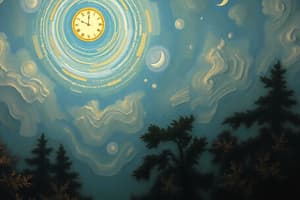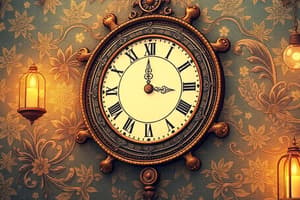Podcast
Questions and Answers
What is the primary function of the suprachiasmatic nucleus (SCN) in circadian rhythms?
What is the primary function of the suprachiasmatic nucleus (SCN) in circadian rhythms?
- Processing visual information from the retina
- Regulating hormone secretion in response to temperature changes
- Controlling the sleep-wake cycle through auditory signals
- Synchronizing the biological clock with external light cues (correct)
Which pathway is primarily involved in the photo entrainment of the circadian clock?
Which pathway is primarily involved in the photo entrainment of the circadian clock?
- Retinohypothalamic tract (correct)
- Geniculohypothalamic pathway
- Optic nerve pathway
- Lateral geniculate nucleus route
How does the phase delay impact melatonin production?
How does the phase delay impact melatonin production?
- It delays the onset of melatonin secretion until later in the night (correct)
- It has no effect on melatonin production patterns
- It increases melatonin synthesis immediately upon exposure to light
- It causes a premature release of melatonin in the morning
Which factor is critical in the entrainment of the circadian clock?
Which factor is critical in the entrainment of the circadian clock?
What does the interrelated effect of the circadian clock influence?
What does the interrelated effect of the circadian clock influence?
Flashcards
Biological Clock
Biological Clock
The natural, internal process that regulates the sleep-wake cycle and other bodily functions in a roughly 24-hour cycle.
Entrainment
Entrainment
The process by which the biological clock is synchronized or reset to the 24-hour light-dark cycle.
Phase Delay
Phase Delay
The process of delaying the biological clock's phase, making it later.
Phase Advance
Phase Advance
Signup and view all the flashcards
Route of Light in Photoentrainment
Route of Light in Photoentrainment
Signup and view all the flashcards
Study Notes
Circadian Rhythms: Organization and Pathways
- The SCN (suprachiasmatic nucleus) is central to organizing afferents, efferents, and local circuits within the CNS.
- Light-dark cycles and social cues influence circadian rhythms.
- The SCN receives input from the retina, influencing rest-activity rhythms, feeding rhythms, and body temperature.
- Other components like peripheral oscillators, food components (e.g., glucose, ethanol), and caloric restriction contribute to entrainment.
- Melatonin entrainment involves the retinohypothalamic tract, paraventricular nucleus, and pineal gland.
Biological Clock Pathway
- The biological clock involves interactions between proteins (e.g., CLOCK, BMAL1, PER, CRY) in the nucleus and cytoplasm.
- These proteins oscillate to control various processes.
- Degradation by proteasomes is crucial in the cycle.
Phase Delay and Phase Response
- Phase response curves and actograms show how light pulses or non-photic stimuli influence activity rhythms.
- Light signals during the night typically cause a phase delay, while signals during the day cause a phase advance.
- Specific molecules like NMDA-R, Ca2+, NO are involved in these phase shifts.
Route of Light in Photoentrainment
- Light from the environment travels through the retina.
- Melanopsin-containing ganglion cells play a crucial role in transmitting light information, influencing the SCN via the retinohypothalamic tract.
- This information affects various aspects of the body's daily rhythms.
Interrelated Effects of Circadian Clock
- Circadian clock disruption impacts mood, sleep, and can worsen comorbidities.
- Aging plays a role in this interplay.
Studying That Suits You
Use AI to generate personalized quizzes and flashcards to suit your learning preferences.




